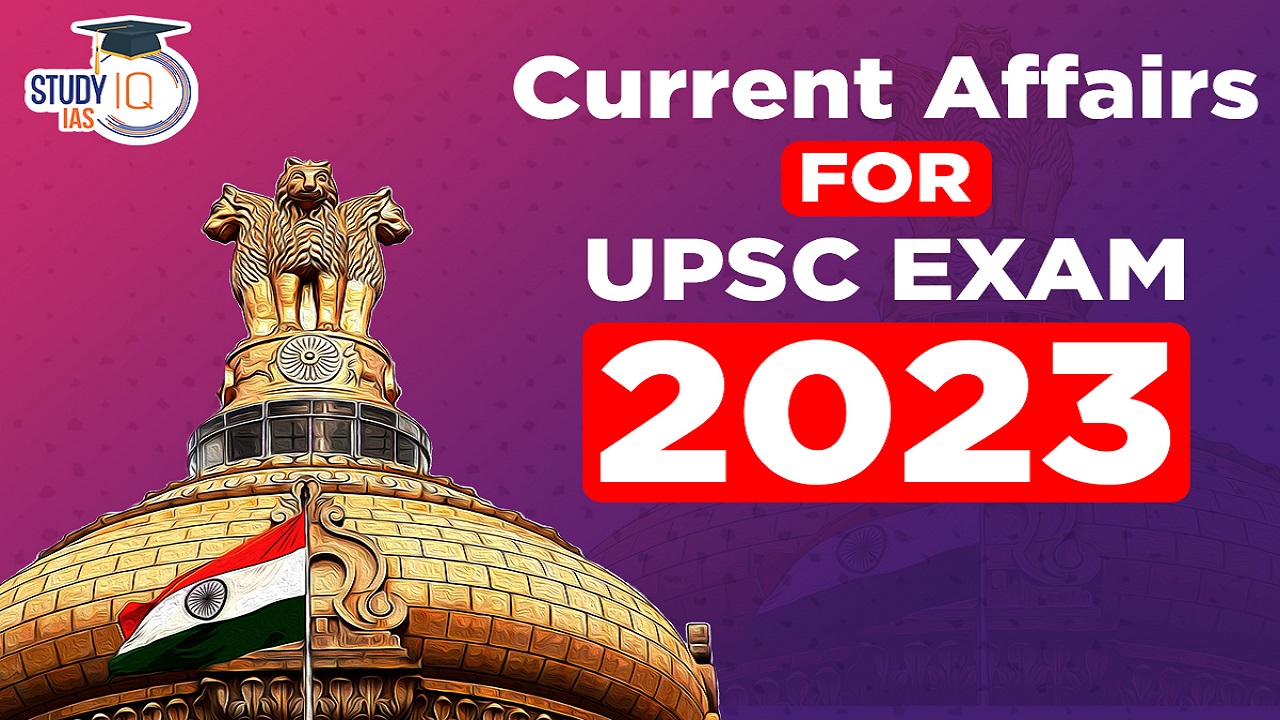Current Affairs 21st July 2023 for UPSC Prelims Exam
Archaeological Survey of India
Context: The Delhi High Court has asked the Archaeological Survey of India (ASI) to clarify its policy on allowing prayers by devotees in religious places located inside protected monuments.
About Archaeological Survey of India (ASI)
- Definition: The Archaeological Survey of India (ASI) is the premier organization for the archaeological research and protection of the cultural heritage of the nation.
- Ministry: Ministry of Culture.
- Foundation: Archaeological Survey of India was founded in 1861 by Alexander Cunningham, the first Director-General of ASI, often called the father of Indian archaeology.
- Functions:
- Maintenance of ancient monuments and archaeological sites and remains of national importance
- Regulation of all archaeological activities in the country as per the provisions of the Ancient Monuments and Archaeological Sites and Remains Act, 1958
- It also regulates Antiquities and Art Treasure Act, 1972
- Architectural survey of monuments
- Training in Archaeology
- Archaeological expeditions outside India
- Conducting archaeological explorations and excavations
- Chemical preservation of monuments and antiquarian remains
- Epigraphical and numismatic studies
- Setting up and re-organization of Site Museums
- Recent Controversy over Worship:
- The Delhi Court was hearing a petition against the stopping of prayers by devotees inside the Mughal Mosque.
- The managing committee of the mosque, which was appointed by the Delhi Waqf Board, had approached the High Court with the grievance that the officials of the ASI completely stopped the offering of namaz in the mosque without any notice.
- According to ASI, the Mughal Mosque area falls within the category of protected monuments on account of being part of the Qutub complex.
- ASI also said that “there is no question” of permitting prayers in protected monuments.
- The court asked the ASI to produce before it the record available with respect to the issuance of a notification declaring the mosque as a protected monument.
Current Affairs 20th July 2023 for UPSC Prelims Exam
Radio Collars
Context: Wildlife officials in Madhya Pradesh have proposed measures including removing radio collars from 10 free-ranging cheetahs at Kuno National Park, in response to the recent deaths of two cheetahs within a three-day period.
What are Radio Collars?
- The cheetah’s movements are tracked using satellite transmitters attached to the collars fitted around the neck of the animal.
- With the help of Satellite Collar IDs, the wildlife officials can closely track their travels, activities and health.
- The GPS in the collars is similar to that used in smartphones and other electronic devices.
- Satellites can easily identify the electronic signals that the GPS chips broadcast. It is designed in such a way that it won’t be destroyed due to animal’s movements.
- Apart from the location, the tool is used to learn about the animal’s physical state as it helps in communicating health-related information which can be used to determine whether the animal needs to be treated or not.
Collaring of Animals:
- Since the 1970s, satellite telemetry has made it possible to monitor individual birds and animals over continental distances.
- These tracking devices have become lighter and more sophisticated over time – so much so that there are VHF radio telemeters for even insects today.
- Globally, the thumb rule is to keep the weight of a radio collar to less than 3% of the animal’s body weight.
- The size of the battery is important – a lighter one would need replacement sooner, which cannot be done without sedating the animal.
- Most modern collars for wild cats weigh around 400 g, which is light enough for cheetahs that typically weigh between 20 kg and 60 kg.
- Cheetahs are hard to fit collars on as their heads are not much bigger than their necks, especially younger animals.
Reasons to Remove Radio collars:
- Radio collars on the cheetahs are suspected to be causing deaths due to potential infections.
- It is believed that during the monsoon season, the high moisture in the environment may lead to the cheetahs scratching their skin more frequently.
- The constant scratching could cause the skin to break, making it susceptible to infections, especially if it comes into contact with flies.
- Flies can lay their eggs in the open wound, leading to maggot infestations and further complications.
Why are Kuno Cheetahs more Vulnerable due to Collars?
- ‘Wet mat’ effect could weaken the skin over time: Cheetahs grow a winter coat. It is more furrier compared to the coats of tigers or leopards and would hold more water and take longer to dry.
- 3% collar weight rule not factoring in “animal athleticism”: During movement, the forces exerted by collars were generally equivalent to up to five times the collar’s weight for a lion and a massive 18 times for a cheetah.
- This would make a 400 g collar ‘weigh’ more than 7 kg on a sprinting cheetah – a lot of weight to carry on a wet coat.
- Less immune to local pathogens: These animals could be vulnerable to certain local pathogens to which Indian tigers and leopards may be immune.
- To address the situation and prevent further casualties, it is proposed to remove the radio collars from the cheetahs, particularly the male coalition of cheetah brothers from Namibia known as “The Rock Stars” and other free-ranging cheetahs at Kuno National Park.
Star Rating Policy For Coal And Lignite Mines
Context: The last date for registration of coal and lignite mines under Star Rating programme has been extended by the Government.
More on News
- The Ministry of Coal has announced the commencement of Star Rating Registration process of Coal and Lignite Mines for the financial year 2022-23.
About Star Rating Programme
- Definition: The Government’s Star Rating policy aims to evaluate mines based on various factors across seven key parameters namely:
- Mining operations
- Environment-related parameters
- Adoption of technologies
- Best mining practices
- Economic performance
- Rehabilitation & resettlement
- Worker-related compliance
- Safety & security.
- Aim: The policy has been introduced to foster competitiveness among mines and recognize their outstanding performance based on compliance of statutory provisions, adoption of advanced mining technology and economic achievements.
- Ministry: Ministry of Coal
- Process: The ratings awarded range from Five Star to NO Star, comprehensively evaluating each mine’s achievements.
- Participating mines are encouraged to undertake a comprehensive self-evaluation process, which should be completed by July 31, 2023.
- Upon completion, the top 10% of the highest-scoring mines will be selected for further validation through an inspection conducted by a committee.
- While the remaining 90% of the mines will undergo an online review process, all participants can contribute to the evaluation by reviewing other mines.
- The comprehensive review will be finalized by October 31, 2023.
- Subsequently, a Coal Controller review will be conducted, leading to the publication of the results by January 31, 2024.
- The evaluation will be conducted by the Coal Controller’s Organization, ensuring transparency and impartiality in the assessment.
National Health Mission
Context: Measures taken by the National Health Mission (NHM) have given a positive fillip to the health sector in India over the past 15 years, a study published in the Public Health For All journal has concluded.
About National Health Mission (NHM)
- Definition: The National Health Mission (NHM) is a Centrally Sponsored Scheme which envisages achievement of universal access to equitable, affordable & quality health care services that are accountable and responsive to people’s needs.
- Aim:
- To provide financial and technical support to States / Union Territories (UTs) enabling them to provide accessible, affordable, accountable, and effective healthcare upto District Hospitals (DHs), especially to the poor and vulnerable sections of the population.
- Bridge the gap in rural healthcare services through:
- Improved health infrastructure,
- Augmentation of human resource
- Improved service delivery in rural areas
- Decentralization of programme to district level to facilitate need-based interventions.
- Improve intra and inter-sectoral convergence and effective utilization of resources.
- Sub Missions: NHM encompasses its two Sub-Missions:
- the National Rural Health Mission (NRHM) and
- the National Urban Health Mission (NUHM).
- Ministry: Ministry of Health and Family Welfare.
- Components: The main programmatic components include:
- Health System Strengthening in rural and urban areas,
- Reproductive-Maternal- Neonatal-Child and Adolescent Health (RMNCH+A),
- Communicable and Non-Communicable Diseases.
- Beneficiaries: NHM is implemented for universal benefit – i.e. entire population; services are offered to everyone visiting the public healthcare facilities with a special focus to vulnerable sections of the society.
- Targets under NHM by 2025:
- Reduce Maternal Mortality Ratio (MMR) to 90 from 113
- Reduce Infant Mortality Rate (IMR) to 23 from 32
- Reduce Under 5 Mortality Rate (U5MR) to 23 from 36
- Sustain Total Fertility Rate (TFR) to 2.1
- Reduce prevalence of Leprosy to <1/10000 population and incidence to zero in all districts
- Annual Malaria Incidence to be <1/1000
- Prevent and reduce mortality & morbidity from communicable, non- communicable; injuries and emerging diseases
- Reduce household out-of-pocket expenditure on total health care expenditure
- Ending the TB epidemic by 2025 from the country.
- Success of NHM:
- Under-five mortality rate(U5MR): It has declined from 49 in 2013 to 36 in 2018.As per SRS 2020, U5MR has further reduced to 32.
- Maternal Mortality Ratio (MMR): It has declined by 443 points from 556 per one lakh live births in 1990 to 113 in 2016-18.
- Infant Mortality Rate(IMR): It has declined from 80 in 1990 to 32 in the year 2018.As per Sample Registration System (SRS) 2020, IMR has further reduced to 28.
- Total Fertility Rate(TFR): As per SRS, TFR in India declined from 2.3 in 2013 to 2.2 in the year 2018.As per SRS 2020, TFR has further reduced to 2.0.
- Malaria: In the year 2020, malaria cases and deaths have declined by 46.28% and 18.18%, respectively.
- TB Cases: The incidence of TB per 1,00,000 population has been reduced from 234 in 2012 to 193 in 2019. The mortality due to TB per 1,00,000 populations for India reduced from 42 in 2012 to 33 in 2019.
- Kala Azar: The percentage of Kala Azar (KA) endemic blocks, achieving the elimination target of < 1 KA case per 10000 population, increased from 74.2% in 2014 to 97.5% in 2020-21.
- Observations Made in Public Health For All Journal:
- The researchers studied the impact of public health policies and the Centre’s contribution in four States – Tamil Nadu, Kerala, Haryana and Bihar. They found that States had slowly increased allocation to their health budgets.
- The States received funding only if they complied with the Central government’s schemes, and States were nudged to enhance investment in primary health care.
- The target of 8% of total State budget has yet to be achieved. The target was envisaged in the National Health Policy of 2017.
- In 2018-2019, states spent an estimated 5.2% of the total budget on health.
- NHM’s conditional allocation has helped that can be seen from the steady fall in the country’s infant mortality rate.
- The disparity in per capita public spending across States has reduced. But the health departments continue to struggle with the issue of underspending of allocated funds.
- States must develop concrete plans to build their primary health care delivery system to achieve one of the key objectives of the NHM – universal health coverage.
- For States to develop a clear road map, the Centre must develop a National Database of Health System Cost, which should be updated with the estimated cost of comprehensive primary health care.
- In this manner, realistic estimates of the cost of delivering (primary, secondary and tertiary) healthcare can be made to arrive at a threshold level of cost-per year of quality adjusted life year (QALY) gained through primary healthcare interventions.


 Micrometeoroids: Tiny Space Particles, M...
Micrometeoroids: Tiny Space Particles, M...
 India Needs a National Insolvency Tribun...
India Needs a National Insolvency Tribun...
 Unlocking the Potential of India–Afric...
Unlocking the Potential of India–Afric...

























